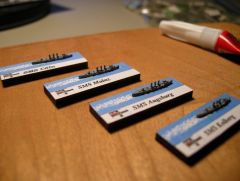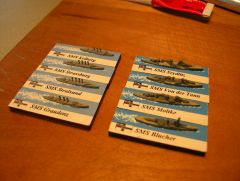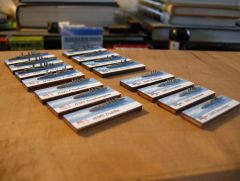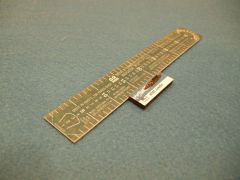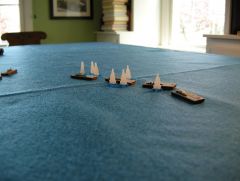So we had the first run-through of our Yarmouth Raid scenario, and the main thing I learned was we're still rusty on the rules. Lots of time spent consulting the rule-book, causing us to run long past our time-limit. Due to some very tight space we adjusted the scale by half, which caused action to look like it was at point-blank ranges occasionally. Still we had some fun and vowed to give it another go soon.
Clear weather with a stiff breeze had the North Sea at a good Force-5 chop, precluding the use of casement weapons and hampering long-distance visibility at deck-level.
Moltke's sharp-eyed spotter provided Admiral Hipper with more than enough time to get his fleet around into a favorable position, but poor maneuvering resulted in the light-cruiser screen being out of position for much of the first half-hour. As Beatty closed from the northwest Hipper directed a course change to the northeast and increased speed.
German battlecruisers turn northeast in the opening minutes.
Beatty continued southeastward intent on cutting off Hipper's line of withdrawal and possible relief from the main-body. At 1302 Moltke opens on Lion at long range without result. Six minutes later, altering her fire onto Princess Royal, Moltke lands a hit resulting in minor damage.
Thus begins a twenty minute period with both lines exchanging fire at extended range. At 1314 Hipper again changes course to head due north.
Beatty's battlecruisers bracketed by long-range fire (the German battle-line can be seen in the distance to the far left).
At 1326 Moltke scores a second hit on Princess Royal, reducing her maximum speed to 25 knots. Hipper alters course again, now heading northwest to begin closing on Beatty. At 1332 Von Der Tann scores a hit on Queen Mary knocking her speed down to 25 knots maximum. The British battlecruisers suffer poor shooting (that D20 dice requirement for the British BC's proves highly-diluting at long range).
At 1344 near-disaster strikes as Von der Tann delivers four rounds onto Lion, Beatty's flagship. One hit takes out her forward turrets and penetrates below decks. Chatfield's order to immediately flood the forward magazine saves the ship from catastrophe, but this and two other hits to the forecastle results in flooding that has her down by the bow and dropping out of the line. Admiral Beatty watches despondently as the others steam past.
With Lion withdrawing to the south Princess Royal takes over at the head of the British column, followed by Queen Mary and New Zealand. Six minutes after Lion is nearly destroyed, New Zealand lands a blow on Seydlitz, penetrating her double 3" deck amidships, wrecking her after engine-room. Seydlitz's current speed of 18 knots becomes her best possible.
A top-side view of the action. Here Hipper's battlecruisers are in the upper right as the German light-cruisers turn inside to make a run at the British battleline on the left.
With the range closing fast, Queen Mary scores two hits on Von der Tann, the first reducing her forward boiler-room to a shambles and the second knocking out her fire-control system. Von der Tann's speed drops to a 17 knot maximum as she continues on. Seconds later New Zealand finds Seydlitz again, this time aft of her conning tower just ahead of the funnel, disabling her fire-control as well.
With the British light-cruiser screen not in position to fend them off, the German light-cruisers strike off toward the British battlecruisers, closing for a possible torpedo attack. Beatty's larger Town-class cruisers, recognizing the threat, desperately attempt to intercept.
The German light-cruisers can be seen here in the center of the photo beginning their run at the three British battlecruisers. Lion is seen limping off to the south.
Hipper's battlecruisers, despite having closed to less than 12,000 yards, find their aim (and luck) has departed. At 1356 Seydlitz finds New Zealand but the damage is minor. It would be their final hit on the British battleline.
The British battlecruisers and light-cruisers have turned their attention to the bull-rushing German light-cruisers. Strassburg and Stralsund suffer multiple hits but continue forward. At 1402 Strassburg suffers a further three hits, one taking out her forward mount and penetrating below decks. Flooding of the forward magazine prevents disaster and she continues on. Stralsund, holed repeatedly, fails her morale check and drops out of the line turning north, nearly colliding with the overtaking Kolberg.
German light-cruisers pass through a murderous barrage to launch their torpedoes.
At 1414 Hipper gives the order to break off. The German light-cruisers, having passed through the maelstrom, launch their torpedoes and turn north for the protection of the heavier battlecruisers (the German player blundered badly here, not understanding that the CL's submerged tubes were broadside-mounted, not forward-mounted...the correcting maneuver together with the fact that they are only single-mounts reduced the potential effectiveness to near nothing). For their part the British turn south, then southeast evading the few torpedoes launched by the Germans. With the intervening distance rapidly expanding, the action comes to an end.
Had the day continued Stralsund would almost certainly have been destroyed, her speed down to just six knots and heavily damaged. She would face up to a year in the yard, or possibly scrapping outright. Lion would be out of action for months, as would Strassburg. Seydlitz and Von der Tann would be laid up for a few weeks while their fire-direction systems were repaired. Osmond Brock and Princess Royal had given a good accounting, as did Halsey's New Zealand. Moltke escaped nearly unscathed, while Blucher and Queen Mary had shot poorly. Struggling to find position throughout the battle, 2nd Light Cruiser Squadron Commander William Goodenough had proven not to be. In the end he was manhandled by Hipper's CL's, and his flagship Southampton would limp home with sisters Chatham and Dublin, The light-cruisers on both sides had, however, proven quite durable in the face of heavy fire.
No decisive victory here for either force, perhaps a slight tip to the British. Beatty, outraged at the poor gunnery of his BC's, will have heads rolling. The Kaiser recommends Hipper for a medal which he refuses.
In the post-game debrief there is a sense that we have left out a lot, inviting a careful reread of the rules and examples. The torpedo (sequencing and tracking) and damage-control (what can be repaired and when) sections require further familiarity. We need to build a bigger table (or move to the driveway), and we need to scrounge up a few more D20's for those poor-ranging Brit BC's. As always, the action feels incredibly condensed in these games, the entire engagement consuming just ninety-nine scale minutes.
In the end we wonder if it is really possible to be just a casual player. I for one think not.
Healey









